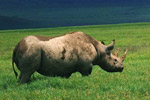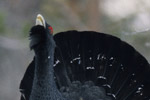In a three week hunting safari between January 11th and 31st of this year, Saudi Arabian Prince Fahd bin Sultan bin Abdulaziz Al Saud and his party allegedly shot down 2,100 Asian Houbara bustards (Chlamydotis macqueenii) in Balochistan, Pakistan. Scientists aren’t certain how many Houbara bustards survive today, but their best estimate is around 100,000 and declining.
Hunting of Houbaras in Pakistan is illegal. But the Pakistani government issued special permits to the Arab royal and senior officials to hunt these migratory birds. Pakistan’s Ministry for Foreign Affairs also issued a “code of conduct” to ensure sustainable hunting and protection of the birds—one that states that hunting will be permitted for a period of 10 days, with a limit of a 100 birds.
The Prince and his party, however, hunted about 100 birds on an average per day. A report by Pakistan’s environmental journalist Bhagwandas in Dawn, a Pakistani daily newspaper, said that the Prince hunted in both non-protected and protected areas. For instance, his party killed about 582 bustards over a six day period inside the Koh-i-Sultan state forest in Pakistan.
 Saudi Arabian Prince Fahd bin Sultan bin Abdulaziz Al Saud whose hunting party shot 2,100 Houbara bustards in Pakistan. Photo by: the U.S. Department of Defense. |
But this is not very unusual.
“Arabian countries have hunting concession areas across parts of South Pakistan where Houbaras winter,” Nigel Collar, Chair of the IUCN Bustard Specialist Group told mongabay.com. “Many have built palaces there in which to stay during the hunting season.”
The Houbara bustard is currently listed as Vulnerable on the IUCN Red List. But every winter, wealthy Arab royals and ministers fly into Pakistan in their private jets, set up large, luxurious camps, and hunt several thousand Houbaras bustard. Why? Because these desert birds are considered to be aphrodisiacs.
Houbara-hunting through falconry has been a part of Bedouin tradition for generations. But by the 1960s, the Arabs had hunted out most of the Houbaras from the Middle East. To continue their Houbara sport-hunting culture they turned to Pakistan. In exchange for billions of dollars that they give to Pakistan as aid, the Arabs get free passes for mass-decimation of the birds. Pakistanis, on the other hand, are prosecuted if caught hunting these ground-dwelling birds.
Pakistan’s neighbor, India, too invited Arab falconers to hunt Houbaras in the 1970s. But as a result of massive public outrage, a High Court order stayed all future Houbara hunting in India. India-based conservation groups are now trying to pressure the Pakistani government to follow suit, but to date without effect.
 The Houbara bustard is listed as Vulnerable by the IUCN Red List with its population in decline. Photo by: Jimfbleak/Creative Commons 3.0. |
In a bid to reintroduce the Asian Houbaras into the wild, Saudi Arabia has also invested billions of dollars for captive breeding. According to Collar, however, the captive population is still too small to be hunted. As a result, hunters seek Houbaras elsewhere.
Falconry and poaching have resulted in a drastic decline of Houbara populations in most of their wintering ranges in Asia. A press release by WWF-Pakistan condemned the hunting and said that the current population status of these birds in Pakistan is not known and needs urgent evaluation.
Collar appears hopeful that solutions can be reached.
“The international conservation community is ready to work with Arab countries, through the Convention on Migratory Species and other agreements and mechanisms, in order to develop systems of management that will allow this hunting to go on (it cannot be stopped, except by the extinction of the Houbara) but that will also ensure that the Houbara survives in very good numbers as a truly sustainable source. This is the fundamental message we need to get across,” he said.
For a first-hand account of a 1992 Houbara hunting expedition with the sheikhs, read here.
.600.jpg)
A distinct subspecies of the Houbara bustard in the Canary Islands. Photo by: Chmee2/Creative Commons 3.0.
Related articles
Chelonians for dinner: hunting threatens at-risk turtles and tortoises in India

(04/23/2014) The extinction risk faced by mammals is often in the limelight. But it may be surprising to learn that next only to primates, chelonians—or turtles and tortoises—are the world’s most imperiled vertebrate group. New research indicates that two such species are being threatened by hunting in the Western Ghats of India.
Small monkeys take over when big primates have been hunted out in the Amazon

(04/21/2014) The barbecued leg of a spider monkey might not be your idea of a sumptuous dinner, but to the Matsés or one of the fifteen tribes in voluntary isolation in Peru, it is the result of a successful hunt and a proud moment for the hunter’s family. However, a spider monkey tends to have only a single infant once every 30 months, which necessarily limits the number of adult monkeys available to subsistence hunters.
Over 9,000 primates killed for single bushmeat market in West Africa every year

(03/24/2014) Over the past 25 years, West Africa’s primates have been put at risk due to an escalating bushmeat trade compounded with forest loss from expanding human populations. In fact, many endemic primates in the Upper Guinea forests of Liberia and Ivory Coast have been pushed to the verge of extinction. To better understand what’s happening, a recent study in mongabay.com’s open-access journal Tropical Conservation Science investigated the bushmeat exchange between these neighboring countries.

(02/20/2014) ‘After a long conversation with the FBI I have decided to temporarily suspend my activity on this page. I want to thank all of you who have commented [on] this important issue of Black Rhino Conservation.’ – Corey Knowlton, Feb 3, 2014. This was the last post on Corey Knowlton’s Facebook page. Knowlton is the hunter who won the Dallas Safari Club auction on January 11th to kill a Critically Endangered black rhino. All the money—$350,000—will go to a fund to protect rhinos. The plan is that sometime soon—once the paperwork clears the U.S. Fish and Wildlife Service—Knowlton will go to Namibia on a “trophy hunt” (accompanied by a park service official), shoot the designated rhino, and bring the old bull’s hide back home to Texas.
How hunters have become key to saving Bulgaria’s capercaillie

(02/04/2014) Surprising clatter cuts through the silence in the snowy forest shortly before sunrise. The powerful clicking sounds like a dropping Ping-Pong ball before culminating in a loud pop resembling the opening of a champagne bottle. This sound is heard clearly and far. Propped on a thick pine tree branch, with a peacock-fanned tale, relaxed wings and head pointing skyward, a western capercaillie is singing. The song terminates with a low-frequency sound similar to scraping a fork to the bottom of a frying pan. It’s exactly during those last few moments of singing that something unusual happens: the male bird goes temporarily deaf. Hence the species’ common name in Bulgarian—deaf bird.
Over 2,500 wolves killed in U.S.’s lower 48 since 2011
(01/28/2014) Hunters and trappers have killed 2,567 gray wolves in the U.S.’s lower 48 states since 2011, according to recent data. Gray wolves (Canis lupus) were protected by the Endangered Species Act (ESA) for nearly 40 years before being stripped of their protection status by a legislative rider in 2011. Last year total wolf populations were estimated at over 6,000 in the region.
Trophy hunters auction off life of Critically Endangered black rhino
(01/13/2014) The Dallas Safari Club has auctioned off a permit to shoot-and-kill a Critically Endangered black rhino in Namibia for $350,000. The club says the proceeds from the auction will aid rhino conservation, but the move has upset many wildlife organizations and attracted protestors outside the closed-door auction. In fact the issue has become so contentious that the FBI is currently investigating purported death threats against the Dallas Safari Club members over the issue. Currently, less than 5,000 black rhinos survive in the wild today, a drop of 90 percent since 1960 as the species has been decimated by poaching and habitat loss.